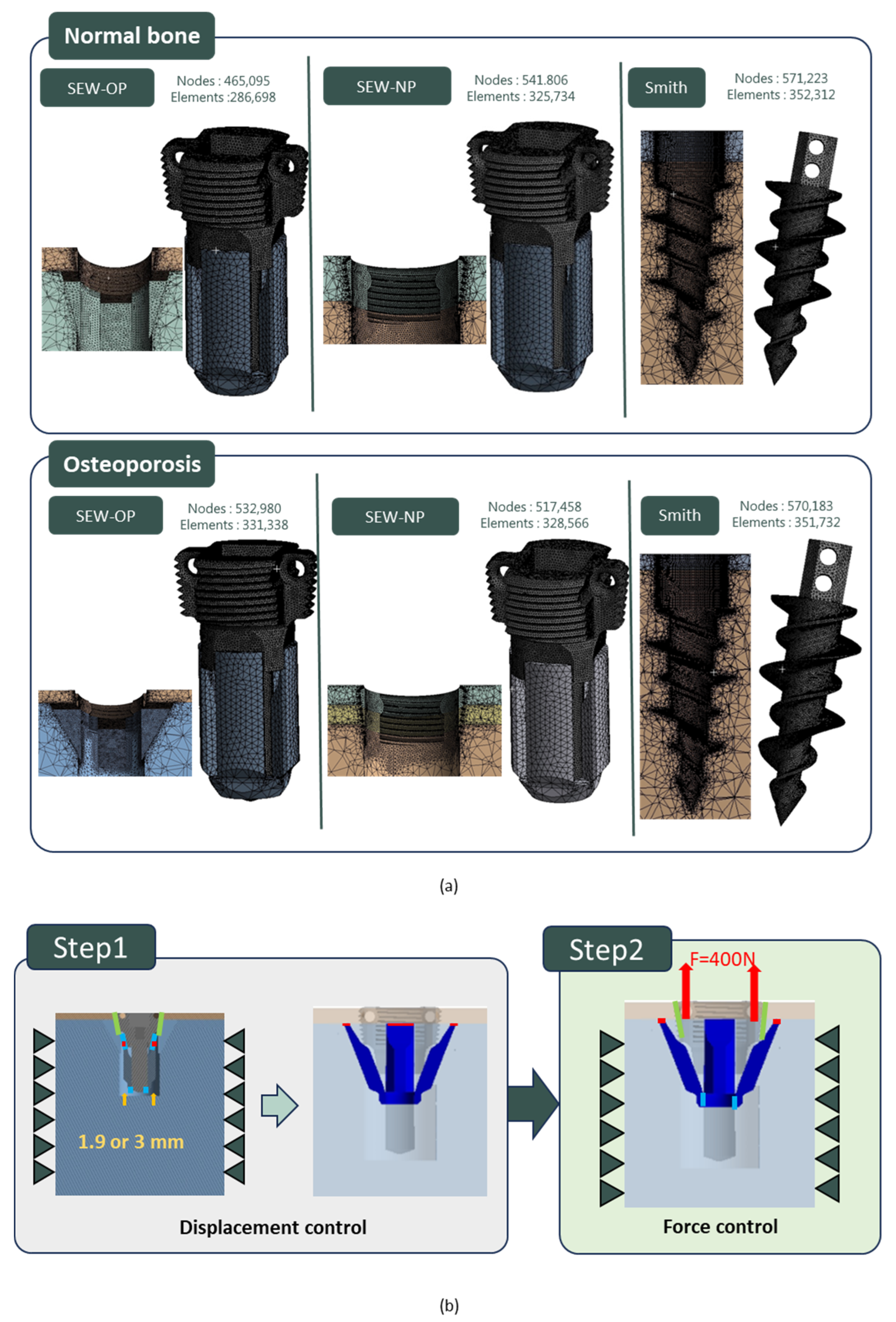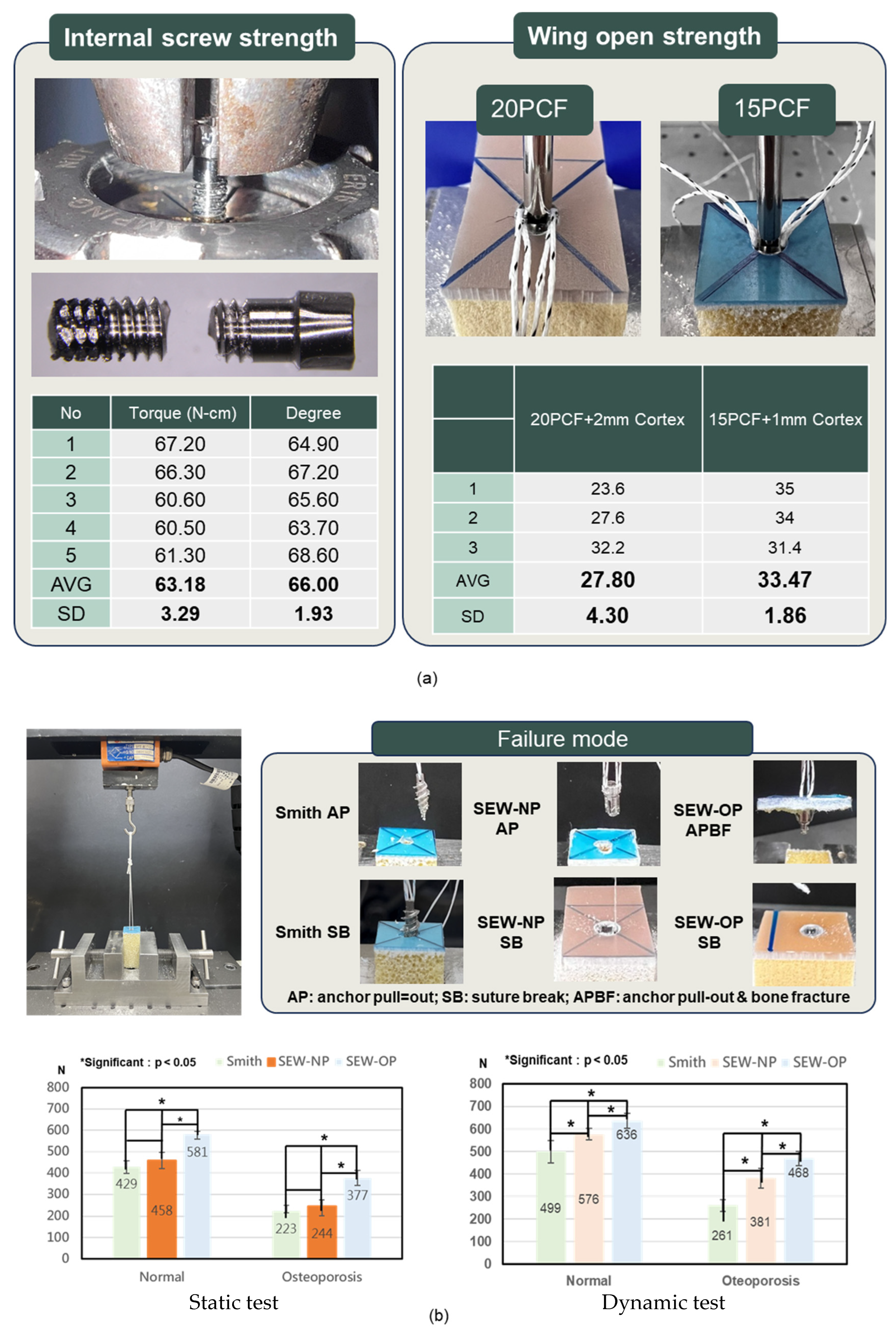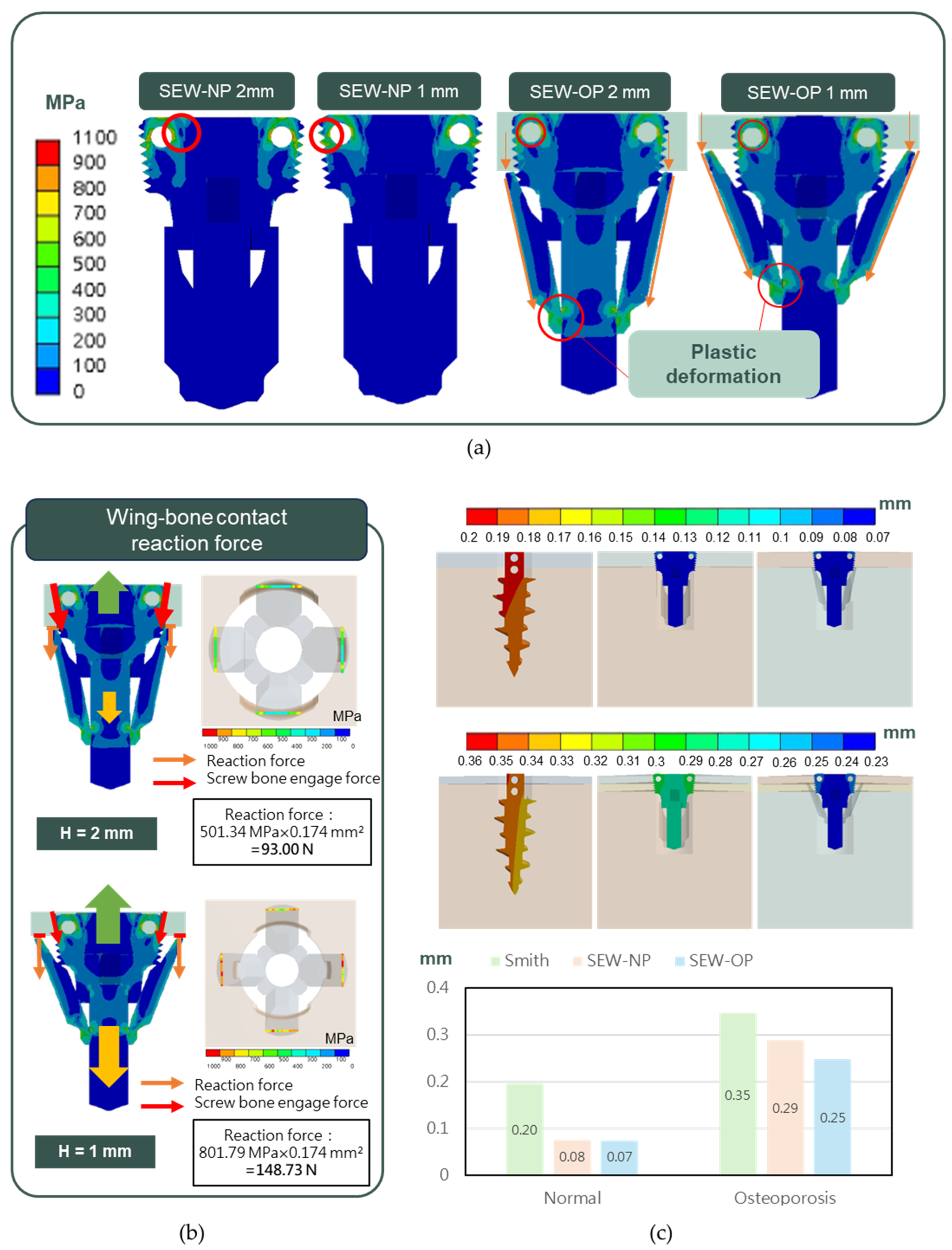Short Expandable-Wing Suture Anchor for Osteoporotic and Small Bone Fixation: Validation in a 3D-Printed Coracoclavicular Reconstruction Model
Abstract
1. Introduction
2. Materials and Methods
2.1. Design Concept of SEW Suture Anchor & Instrument
2.2. HU-Based Mechanical Property Conversion and Artificial Bone Matching
2.3. Finite Element Analysis for SEW Suture Anchor Under Different Bone Quality
2.4. Manufacturing of SEW Suture Anchor and Static/Dynamic Mechanical Testing
2.5. Biomechanical Evaluation of SEWs at Coracoclavicular Reconstruction Model
3. Results
4. Discussion
5. Conclusions
Author Contributions
Funding
Institutional Review Board Statement
Informed Consent Statement
Data Availability Statement
Acknowledgments
Conflicts of Interest
References
- Chaudhry, S.; Dehne, K.; Hussain, F. A review of suture anchors. Orthop. Trauma 2019, 33, 263–270. [Google Scholar] [CrossRef]
- Braunstein, V.; Ockert, B.; Windolf, M.; Sprecher, C.M.; Mutschler, W.; Imhoff, A.; Postl, L.K.L.; Biberthaler, P.; Kirchhoff, C. Increasing pullout strength of suture anchors in osteoporotic bone using augmentation—A cadaver study. Clin. Biomech. 2015, 30, 243–247. [Google Scholar] [CrossRef]
- Horoz, L.; Hapa, O.; Barber, F.A.; Hüsemoğlu, B.; Özkan, M.; Havitçioğlu, H. Suture anchor fixation in osteoporotic bone: A biomechanical study in an ovine model. Arthrosc. J. Arthrosc. Relat. Surg. 2017, 33, 68–74. [Google Scholar] [CrossRef]
- Rosso, C.; Weber, T.; Dietschy, A.; de Wild, M.; Müller, S. Three anchor concepts for rotator cuff repair in standardized physiological and osteoporotic bone: A biomechanical study. J. Shoulder Elb. Surg. 2020, 29, e52–e59. [Google Scholar] [CrossRef]
- Yang, Y.S.; Shih, C.A.; Fang, C.J.; Huang, T.T.; Hsu, K.L.; Kuan, F.C.; Su, W.R.; Hong, C.K. Biomechanical comparison of different suture anchors used in rotator cuff repair surgery-all-suture anchors are equivalent to other suture anchors: A systematic review and network meta-analysis. J. Exp. Orthop. 2023, 10, 45. [Google Scholar] [CrossRef] [PubMed]
- Cho, C.H.; Bae, K.C.; Kim, D.H. Biomaterials used for suture anchors in orthopedic surgery. Clin. Orthop. Surg. 2021, 13, 287–292. [Google Scholar] [CrossRef] [PubMed]
- Hsu, W.C.; Wu, G.L.; Yeh, M.L. Fixation technique of biodegradable magnesium alloy suture anchor in the rotator cuff repair of the shoulder in a goat model: A technical note. BMC Musculoskelet. Disord. 2024, 25, 246. [Google Scholar] [CrossRef]
- Chae, S.W.; Kang, J.Y.; Lee, J.; Han, S.H.; Kim, S.Y. Effect of structural design on the pullout strength of suture anchors for rotator cuff repair. J. Orthop. Res. 2018, 36, 3318–3327. [Google Scholar] [CrossRef]
- Trindade, R.; Albrektsson, T.; Galli, S.; Prgomet, Z.; Tengvall, P.; Wennerberg, A. Bone immune response to materials, part I: Titanium, PEEK and copper in comparison to sham at 10 days in rabbit tibia. J. Clin. Med. 2018, 7, 526. [Google Scholar] [CrossRef] [PubMed]
- Guyer, R.D.; Abitbol, J.J.; Ohnmeiss, D.D.; Yao, C. Evaluating osseointegration into a deeply porous titanium scaffold: A biomechanical comparison with PEEK and allograft. Spine 2016, 41, E1146–E1150. [Google Scholar] [CrossRef]
- Zhang, M.; Deng, L.; Zhang, B.; Liu, J.; Yang, C.; Liu, T.; Yang, Z.; Jiang, J.; Kang, X.; Yun, X. Enhancing rotator cuff repair in rabbit osteoporosis with chitosan quaternary ammonium salt-coated nickel-titanium memory alloy anchors. Am. J. Sports Med. 2025, 53, 406–417. [Google Scholar] [CrossRef]
- Chen, C.H.; Chang, W.J.; Chen, Y.S.; Chen, K.H.; Huang, S.F.; Hsueh, H.R.; Li, C.B.; Lin, C.L. Development of a novel hybrid suture anchor for osteoporosis by integrating titanium 3D printing and traditional machining. Int. J. Bioprinting 2022, 8, 161–171. [Google Scholar] [CrossRef]
- Yamauchi, S.; Tsukada, H.; Sasaki, E.; Sasaki, S.; Kimura, Y.; Yamamoto, Y.; Tsuda, E.; Ishibashi, Y. Biomechanical analysis of bioabsorbable suture anchors for rotator cuff repair using osteoporotic and normal bone models. J. Orthop. Sci. 2022, 27, 115–121. [Google Scholar] [CrossRef]
- Schonebaum, D.I.; Garbaccio, N.; Escobar-Domingo, M.J.; Wood, S.; Smith, J.E.; Foster, L.; Mehdizadeh, M.; Cordero, J.J.; Foppiani, J.A.; Choudry, U.; et al. Comparing biomechanical properties of bioabsorbable suture anchors: A comprehensive review. Biomimetics 2025, 10, 175. [Google Scholar] [CrossRef]
- Li, X.; Xiao, Y.; Shu, H.; Sun, X.; Nie, M. Risk factors and corresponding management for suture anchor pullout during arthroscopic rotator cuff repair. J. Clin. Med. 2022, 11, 6870. [Google Scholar] [CrossRef] [PubMed]
- Ntalos, D.; Huber, G.; Sellenschloh, K.; Saito, H.; Püschel, K.; Morlock, M.M.; Frosch, K.H.; Klatte, T.O. All-suture anchor pullout results in decreased bone damage and depends on cortical thickness. Knee Surg. Sports Traumatol. Arthrosc. 2021, 29, 2212–2219. [Google Scholar] [CrossRef] [PubMed]
- Fat, D.L.; Kennedy, J.; Galvin, R.; O’Brien, F.; Grath, F.M.; Mullett, H. The Hounsfield value for cortical bone geometry in the proximal humerus—An in vitro study. Skelet. Radiol. 2012, 41, 557–568. [Google Scholar]
- Morgan, E.F.; Bayraktar, H.H.; Keaveny, T.M. Trabecular bone modulus-density relationships depend on anatomic site. J. Biomech. 2003, 36, 897–904. [Google Scholar] [CrossRef]
- Liu, G.; Wang, X.; Wang, X.; Zhang, Y.; Ma, Y.; Zhou, H.; Shen, G. Opportunistic screening for local osteoporosis of the proximal humerus on the basis of Hounsfield units: A study of patients with rotator cuff tears. Orthop. Surg. 2025, 17, 1124–1132. [Google Scholar] [CrossRef]
- Reeves, J.M.; Knowles, N.K.; Athwal, G.S.; Johnson, J.A. Methods for post hoc quantitative computed tomography bone density calibration: Phantom-only and regression. J. Biomech. Eng. 2018, 140, 094501. [Google Scholar] [CrossRef]
- Lin, Y.S.; Chang, Y.Z.; Yu, J.H.; Lin, C.L. Do dual-thread orthodontic mini-implants improve bone/tissue mechanical retention? Implant Dent. 2014, 23, 653–658. [Google Scholar] [CrossRef]
- Weidling, M.; Heilemann, M.; Schoenfelder, S.; Heyde, C.E. Influence of thread design on anchorage of pedicle screws in cancellous bone: An experimental and analytical analysis. Sci. Rep. 2022, 12, 8051. [Google Scholar] [CrossRef]
- de Kater, E.P.; Blom, M.N.; van Doorn, T.C.; Tieu, Q.H.; Jager, D.J.; Sakes, A.; Breedveld, P. Enhancing spinal bone anchor pull-out resistance with an L-shaped anchor. PLoS ONE 2024, 19, e0302996. [Google Scholar] [CrossRef]
- Nagamoto, H.; Yamamoto, N.; Itoi, E. Effect of anchor threads on the pullout strength: A biomechanical study. J. Orthop. 2018, 15, 878–881. [Google Scholar] [CrossRef]
- Kim, J.H.; Hyeok, J.J.; Woo, J.H.; Kim, S.M. Correlation analysis of suture anchor pull-out strength with cortical bone thickness and cancellous bone density on a finite element model. Bioengineering 2025, 12, 863. [Google Scholar] [CrossRef] [PubMed]
- Yu, C.; Sun, L.; Gao, H.; Sheng, H.; Feng, X.; Yang, X.; Li, J.; Kong, Q.; Hao, Y.; Feng, S.; et al. Rotator cuff repair with all-suture anchor enhances biomechanical properties and tendon-bone integration in a rabbit model. Heliyon 2024, 10, e37707. [Google Scholar] [CrossRef] [PubMed]
- Alt, P.S.; Marx, C.; Braun, S. All-suture anchor size and drill angle influence load to failure in a porcine model of subpectoral biceps tenodesis, a biomechanical study. BMC Musculoskelet. Disord. 2024, 25, 408. [Google Scholar] [CrossRef]
- Ock, J.; Seo, J.; Koh, K.H.; Kim, N. Comparing the biomechanical properties of conventional suture and all-suture anchors using patient-specific and realistic osteoporotic and non-osteoporotic phantom using 3D printing. Sci. Rep. 2023, 13, 20976. [Google Scholar] [CrossRef]
- Ergün, S.; Akgün, U.; Barber, F.A.; Karahan, M. The clinical and biomechanical performance of all-suture anchors: A systematic review. Arthrosc. Sports Med. Rehabilitation 2020, 2, e263–e275. [Google Scholar] [CrossRef] [PubMed]
- Shih, J.T.; Yeh, T.T.; Wu, C.C.; Shen, P.H.; Wang, C.C.; Chien, W.C.; Chung, C.H.; Wang, S.H. Hook plate fixation with and without coracoclavicular ligament augmentation with suture anchors for acute acromioclavicular joint dislocation. J. Med Sci. 2021, 41, 221–227. [Google Scholar] [CrossRef]
- Liu, C.T.; Yang, T.F. Hook plate with or without coracoclavicular ligament augmentation in the treatment of acute acromioclavicular separation. BMC Musculoskelet. Disord. 2020, 21, 701. [Google Scholar] [CrossRef]
- Huang, L.; Cai, L.; Fan, M.; Yu, P.; Tu, D. Subacromial osteolysis following hook plate fixation for acromioclavicular dislocation: A systematic review and meta-analysis. J. Shoulder Elb. Surg. 2024, 33, 2086–2095. [Google Scholar] [CrossRef]
- Jia, Y.; He, N.; Liu, J.; Zhang, G.; Zhou, J.; Wu, D.; Wei, B.; Yun, X. Morphometric analysis of the coracoid process and glenoid width: A 3D-CT study. J. Orthop. Surg. Res. 2020, 15, 69. [Google Scholar] [CrossRef]
- Eecke, E.V.; Struelens, B.; Muermans, S. Long-term clinical and radiographic outcomes of arthroscopic acromioclavicular stabilization for acute acromioclavicular joint dislocation. Clin. Shoulder Elb. 2024, 27, 219–228. [Google Scholar] [CrossRef] [PubMed]
- Hong, C.K.; Kuan, F.C.; Hsu, K.L.; Chen, Y.; Chiang, C.H.; Su, W.R. Biomechanical comparison of coracoclavicular fixation using metallic versus all-suture anchors. Orthop. J. Sports Med. 2024, 12, 23259671231222505. [Google Scholar] [CrossRef] [PubMed]
- Liu, S.; Li, C.; Song, Z.; Bai, X.; Wu, H. Comparison of open reduction and fixation with hook plate and modified closed reduction and fixation with tightrope loop plate for treatment of rockwood type III acromioclavicular joint dislocation. BMC Musculoskelet. Disord. 2022, 23, 301. [Google Scholar] [CrossRef] [PubMed]
- Shin, S.J.; Kim, N.K. Complications after arthroscopic coracoclavicular reconstruction using a single adjustable-loop-length suspensory fixation device in acute acromioclavicular joint dislocation. Arthrosc. J. Arthrosc. Relat. Surg. 2015, 31, 816–824. [Google Scholar] [CrossRef] [PubMed]
- Jeong, J.Y.; Chun, Y.M. Treatment of acute high-grade acromioclavicular joint dislocation. Clin. Shoulder Elb. 2020, 23, 159–165. [Google Scholar] [CrossRef] [PubMed]
- ASTM F136-21; Standard Specification for Wrought Titanium-6Aluminum-4Vanadium ELI (Extra Low Interstitial) Alloy for Surgical Implant Applications. ASTM International: West Conshohocken, PA, USA, 2021.
- ASTM F543-23; Standard Specification and Test Methods for Metallic Medical Bone Screws. ASTM International: West Conshohocken, PA, USA, 2023.
- Alemayehu, D.B.; Todoh, M.; Huang, S.J. Hybrid biomechanical design of dental implants: Integrating solid and gyroid triply periodic minimal surface lattice architectures for optimized stress distribution. J. Funct. Biomater. 2025, 16, 54. [Google Scholar] [CrossRef] [PubMed]
- Zhang, J.; Chen, X.; Sun, Y.; Yang, J.; Chen, R.; Xiong, Y.; Hou, W.; Bai, L. Design of a biomimetic graded TPMS scaffold with quantitatively adjustable pore size. Mater. Des. 2022, 218, 110665. [Google Scholar] [CrossRef]
- Liu, Y.; Zhang, X.; Yu, Y.; Ding, W.; Gao, Y.; Wang, Y.; Yang, R.; Dhawan, V. Suture augmentation of acromioclavicular and coracoclavicular ligament reconstruction for acute acromioclavicular dislocation. Medicine 2021, 100, e27007. [Google Scholar] [CrossRef] [PubMed]







| Anchor | Smith | SEW-NP | SEW-OP | |||
|---|---|---|---|---|---|---|
| No. | Max Load | Failure Mode | Max Load | Failure Mode | Max Load | Failure Mode |
| 1 | 455 | AP | 515 | SB | 560 | SB |
| 2 | 392 | SB | 448 | SB | 604 | SB |
| 3 | 435 | AP | 455 | SB | 574 | SB |
| 4 | 409 | AP | 406 | AP | 584 | SB |
| 5 | 457 | AP | 470 | AP | 582 | SB |
| AVG | 429 | 458 | 581 | |||
| SD | 28.59 | 39.34 | 16.01 | |||
| Anchor | Smith | SEW-NP | SEW-OP | |||
|---|---|---|---|---|---|---|
| No. | Max Load | Failure Mode | Max Load | Failure Mode | Max Load | Failure Mode |
| 1 | 212 | AP | 216 | AP | 363 | APBF |
| 2 | 202 | AP | 242 | AP | 383 | APBF |
| 3 | 197 | AP | 262 | AP | 348 | APBF |
| 4 | 248 | AP | 287 | AP | 358 | APBF |
| 5 | 257 | AP | 214 | AP | 436 | APBF |
| AVG | 223 | 244 | 377 | |||
| SD | 27.4 | 31.07 | 35.46 | |||
| Anchor | Smith | EPACT UE | EPACT E | |||
|---|---|---|---|---|---|---|
| No. | Max Load | Failure Mode | Max Load | Failure Mode | Max Load | Failure Mode |
| 1 | 481 | AP | 543 | SB | 659 | SB |
| 2 | 585 | AP | 572 | AP | 592 | SB |
| 3 | 499 | AP | 586 | SB | 615 | SB |
| 4 | 456 | AP | 605 | SB | 636 | SB |
| 5 | 476 | AP | 582 | SB | 678 | SB |
| AVG | 499 | 576 | 636 | |||
| SD | 50.33 | 26.32 | 34.13 | |||
| Anchor | Smith | SEW-NP | SEW-OP | |||
|---|---|---|---|---|---|---|
| No. | Max Load | Failure Mode | Max Load | Failure Mode | Max Load | Failure Mode |
| 1 | 241 | AP | 415 | AP | 493 | SB |
| 2 | 238 | AP | 314 | AP | 471 | APBF |
| 3 | 263 | AP | 409 | AP | 491 | APBF |
| 4 | 303 | AP | 363 | AP | 417 | APBF |
| 5 | 258 | AP | 402 | AP | 470 | APBF |
| AVG | 261 | 381 | 468 | |||
| SD | 26.13 | 42.37 | 30.64 | |||
Disclaimer/Publisher’s Note: The statements, opinions and data contained in all publications are solely those of the individual author(s) and contributor(s) and not of MDPI and/or the editor(s). MDPI and/or the editor(s) disclaim responsibility for any injury to people or property resulting from any ideas, methods, instructions or products referred to in the content. |
© 2025 by the authors. Licensee MDPI, Basel, Switzerland. This article is an open access article distributed under the terms and conditions of the Creative Commons Attribution (CC BY) license (https://creativecommons.org/licenses/by/4.0/).
Share and Cite
Tsai, C.-H.; Huang, S.-F.; Lin, R.-C.; Lee, P.-W.; Lee, C.-Y.; Lin, C.-L. Short Expandable-Wing Suture Anchor for Osteoporotic and Small Bone Fixation: Validation in a 3D-Printed Coracoclavicular Reconstruction Model. J. Funct. Biomater. 2025, 16, 379. https://doi.org/10.3390/jfb16100379
Tsai C-H, Huang S-F, Lin R-C, Lee P-W, Lee C-Y, Lin C-L. Short Expandable-Wing Suture Anchor for Osteoporotic and Small Bone Fixation: Validation in a 3D-Printed Coracoclavicular Reconstruction Model. Journal of Functional Biomaterials. 2025; 16(10):379. https://doi.org/10.3390/jfb16100379
Chicago/Turabian StyleTsai, Chia-Hung, Shao-Fu Huang, Rong-Chen Lin, Pao-Wei Lee, Cheng-Ying Lee, and Chun-Li Lin. 2025. "Short Expandable-Wing Suture Anchor for Osteoporotic and Small Bone Fixation: Validation in a 3D-Printed Coracoclavicular Reconstruction Model" Journal of Functional Biomaterials 16, no. 10: 379. https://doi.org/10.3390/jfb16100379
APA StyleTsai, C.-H., Huang, S.-F., Lin, R.-C., Lee, P.-W., Lee, C.-Y., & Lin, C.-L. (2025). Short Expandable-Wing Suture Anchor for Osteoporotic and Small Bone Fixation: Validation in a 3D-Printed Coracoclavicular Reconstruction Model. Journal of Functional Biomaterials, 16(10), 379. https://doi.org/10.3390/jfb16100379









